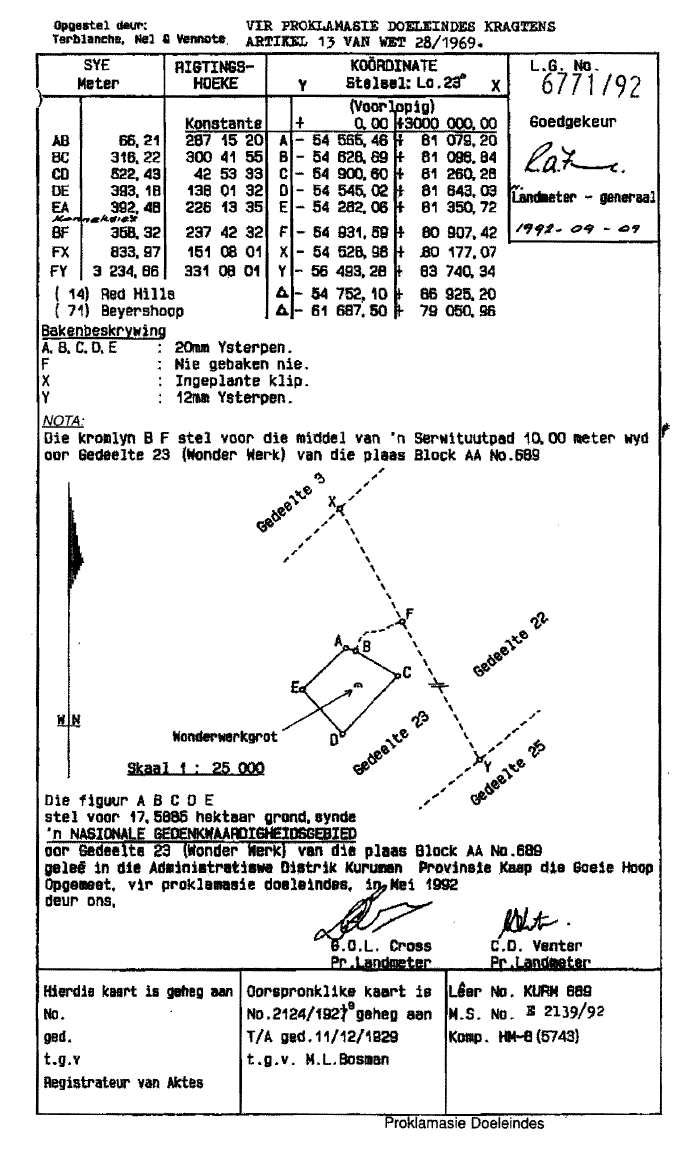 Administration of Estates Act, 1965
Administration of Estates Act, 1965
R 385
National Heritage Resources Act, 1999 (Act No. 25 of 1999)NoticesDeclaration of "Wonderwerk Cave", Portion of Portion 23 of Farm, Block AA 689, (in Kuruman) as a National Heritage Site |
Notice No. 178
12 March 2010
Department of Arts and Culture
South African, Heritage Resources Agency
By virtue of the powers vested in the South African Heritage Resources Agency in terms of section 27(5) of the National Heritage Resources Act, 25 of 1999, SAHRA hereby declares "Wonderwerk Cave" situated on Portion of Portion 23 of farm BLOCK AA 689 in Kuruman, as a National Heritage Site.
SITE SIGNIFICANCE
Research at Wonderwerk Cave, in the eastern Kuruinan Hills, has generated important insights into nearly two million years of human history. The site comprises a 140 m deep cave with a 6 m archaeological deposit, as well as a portion of the Wonderwerk farm property. It was ceded to the McGregor Museum as a heritage site and public servitude. It is a declared Provincial Heritage Site and has been graded Grade 1 by SAHRA Council. It was nominated as part of a serial nomination, with Border Cave and Klasies River Mouth, for the tentative list for World Heritage Sites, and this has since been changed to an individual nomination for the site.
In terms of the criteria set out in Section 3(3} of the National Heritage Resources Act (Act No. 25 of 1999) Wonderwerk Cave qualifies for national heritage status on several criteria. Research, since the 1940s, into the archaeological deposits within Wonderwerk Cave has testified to the site's importance in the pattern of South Africa's history. Some 6 m deep, the deposits are estimated to span nearly 2 million years. This includes a long Stone Age sequence from Oldowan and Acheulean· to Later Stone Age times, ending with evidence of occupation by the first white settlers, who lived in the cave in the early twentieth century.
Wonderwerk Cave exhibits rare and endangered aspects of South Africa's cultural heritage. Distinctive rock paintings on the cave walls date from the last thousand years. In the Later Stone Age levels (c. 11 000 BP to <1000 BP) some of the older dated rock engravings known from the, African continent were found. A fragment of engraved haematite from still older Middle Stone Age levels may be c. 70000 years old. In Middle and Earlier Stone Age levels, besides a lithic sequence through Acheulean to Howiesons Poort, there is early evidence for controlled use of fire (ash, burnt stone and calcined bone), grass bedding and pigment usage. Together these are suggestive of aspects of behavioural modernity in the emergence of modern humans. Environmental evidence bearing on human development in the region is provided in the exceptionally well preserved animal bones (including species which became extinct in early Holocene times, with human agency as a probable contributory factor) and other palaeoenvironmental indicators.
Research at Wonderwerk has already proven the potential of the site to yield information on human, natural and cultural heritage over the past nearly 2 million years. Several different dating techniques and other forms of analysis have been and are being applied.
Greater chronological control will provide a basis for a fuller interpretation. The multiplestratum sequence spanning Oldowan and Acheulean to Later Stone Age times provides a unique record of palaeoenvironmental and human history, including some of the phases during which anatomically modern human forms and behavioural characteristics were emerging.
Wonderwerk Cave is unique in the Northern Cape in demonstrating the characteristics of cave sites of this period. It is one of the, vety few known localities in South Africa with a multiple-stratum archaeological sequence with good organic preservation spanning the Middle Pleistocene. It is one of the very few cave sites containing Acheulean material, let alone Oldowan, while part of its cultural succession also complements the archaeological record from key sites reflecting the emergence of modern humans, such as Klasies River Mouth and Border Cave. In sum, it provides a unique record of palaeoenvironmental and human history in important phases of human evolution, and sheds light on the development of rock art on the African continent.
The site has yielded evidence of the development 'of rock art from Middle Stone Age times to within the last 1000 years. The significance of this, which has continental and even world-wide heritage value and implications in terms of the development of human behaviour, has been alluded to above.
As indicated above, the site has yielded exceptional evidence for early development of art forms, while the lithic industries have been pivotal in defining cultural stratigraphies for the interior, where few other stratified cave sites exist, thus demonstrating creative and technical achievement. It is indeed one of the few cave sites in the subcontinent with Acheulean levels, also yielding artefacts in a kind of raw material and adequate state of preservation for microwear analysis of, for example, hand axes.
While in some senses the site can be said to have universal cultural relevance, the upper levels and the finger paintings on its walls would have strong spiritual associations for the Khoe-San people of the region whose ancestry can be traced into' Later Stone Age times.
DESCRIPTlON
The following property falls within the protected area:
|
Site Name |
Farm |
Portion |
Province |
SG Diagram |
Figure |
Extent |
Deed of Transfer |
|
Wonderwerk Cave |
Block AA 689 Division of Kuruman |
Portion of Portion 23 (Wonder Werk) |
Northern Cape |
L.G. 6771/92 |
ABCDE |
17,5885 ha |
2124/1929 |
